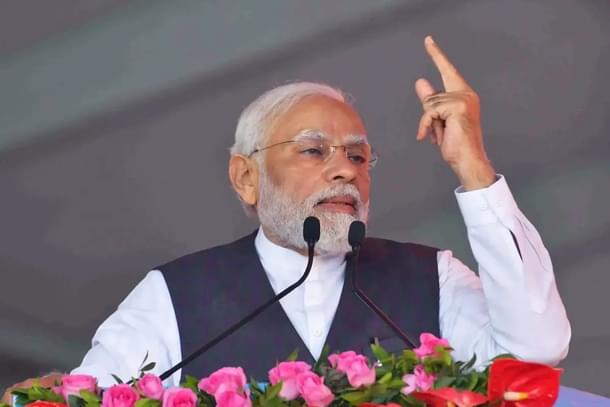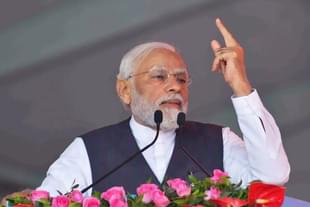Politics
The Stock Markets And Modi: What They See, And What They Cannot
R Jagannathan
May 16, 2024, 11:32 AM | Updated May 17, 2024, 06:01 PM IST
Save & read from anywhere!
Bookmark stories for easy access on any device or the Swarajya app.


The stock markets have been behaving in a wayward manner in recent weeks, and most of that is attributed to uncertainties over the Lok Sabha election results.
Home Minister Amit Shah, who expects his party to romp home on 4 June, advised investors to buy before that day, for after that the markets may rise as the uncertainties end.
To be sure, that is not always how the markets react to the end of uncertainty. The normal rule is that smart money invests during periods of uncertainty, and then when certainty is at hand, these investors book profits.
So, one short-term outcome after 4 June could well be a stock decline due to profit-booking. Over the medium term of a year or more, the markets will rise or fall based on several things, including the government’s performance, the global economy, and geopolitical developments.
One cannot say it with confidence, but a good part of the market’s nervousness relates not to our own elections, but two global wars that show no signs of ending, global election outcomes (US and UK, among them) and the prospects of the US, European and Chinese economies over the next two years, among other things.
The only election issue the market may worry about is whether Narendra Modi will get a majority of his own, or will have to depend on wayward allies to run a government.
This uncertainty has been compounded by India’s excruciatingly-long election timetable, which is not only spread over seven phases, but takes nearly 50 days to complete from the sounding of the poll bugle in mid-March to the final march to the victory podium on 4 June.
Given the sheer amount of misinformation now being peddled by social media and false statements of bravado and impending victory from the opposition parties, the market’s jitters have been accentuated this year.
But here’s a reality check from 2019. In a first-past-the-post system, where the winning party will have less than 50 per cent of the vote in most places and usually less than 50 per cent of the seats, it will always seem like the opposition is doing better in the initial phases.
Let’s consider 2019, where too we had seven phases of polling. In the first phase we had 91 seats going to the polls, followed by the second phase with 97, the third phase with 115, and the fourth, fifth, sixth and seventh phases with 71, 51, 59, and 59 seats respectively.
This time, the number of seats going to the polls is 102 in the first phase, 88 in the second, and 94, 96, 49, 58 and 57 in the remaining phases. In 2019, by the fourth phase, 374 seats had finished polling; this time the number will be similar, at 379 seats.
Depending on which state is voting in which phase, the prospects of the BJP will ebb or flow. A sense of which party is winning, unless it is a wave election, does not come before the fourth or fifth phases.
An analysis by Shrinivas Gour in Moneycontrol.com (read this very useful article here) shows that the BJP started slow in the first two phases in 2019, and went past the combined opposition tally only in the fifth phase. Full majority came in the sixth phase.
This should be commonsense, but here is the reasoning. This time it was the southern states, with 130 seats between them, which completed their polling by the fourth phase. And even though the BJP was expected to do better this time (except in Karnataka), the combined opposition’s tally, including polling in BJP-friendly states, would indeed have been ahead in these phases.
This time, too, the BJP, despite some possible losses for NDA allies in Maharashtra, Bihar, Karnataka (and, some say Rajasthan and Haryana as well), will come out tops in phases five and six.
The reason why many election gyanis tend to give the BJP lower numbers than what was widely expected are the following: one, this is a waveless election; the BJP-Sangh cadre may have thought that the election was already in the bag and hence may not have gone out to vote, and, three, there is huge minority consolidation behind the INDI Alliance.
But was 2019 really any different? Was it really a “wave” election? There is a tendency to give too much importance to Pulwama and Balakot, which was then decoded as a pro-Modi “wave”. The truth is the basic mood of the electorate was in favour of giving Modi another chance, because the voter believed his intentions were good.
Even with a disruptive demonetisation to contend with, the poor saw this as Modi’s intent to go after the big fish with black money. The BJP won the Uttar Pradesh elections in the shadow of DeMo.
Then there was the Ujjwala scheme, Jan Dhan, direct benefits transfers, and the PM Kissan Samman payouts. These things formed the basic cake of Modi’s election offering, to which Balakot added the icing. The basic push in favour of Modi was underneath the surface micro-wave that Balakot created.
In 2024, the same factors predominate. Most women in rural areas and the middle classes see Modi as their ladder to aspirations. While the freebies offered by the INDI Alliance do count, the underlying theme is that Modi has done nothing wrong to deserve defeat.
Also, most people know that a disparate coalition will not deliver the goods. We tend to presume that the average voter is only concerned with her free bus rides and 'guarantees', and not what happens to the rest of the country. Everyone knows freebies cannot last forever.
2024 is like an underwater current that cannot be seen easily at the surface. Modi is sure to return. The only question is the size of the majority. The opposition is mistaken to believe that the voter is driven purely by narrow selfishness.
Jagannathan is former Editorial Director, Swarajya. He tweets at @TheJaggi.





